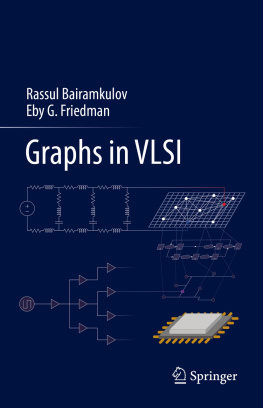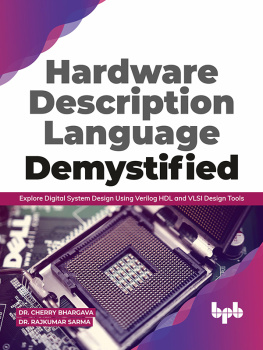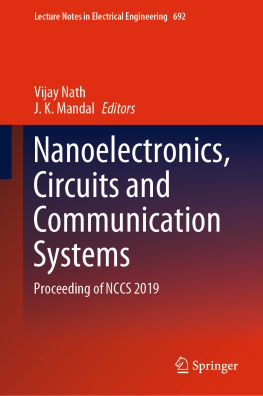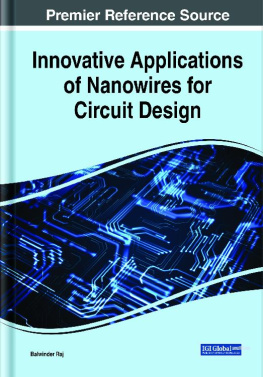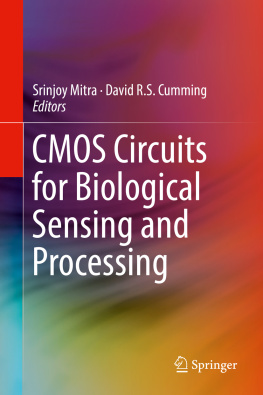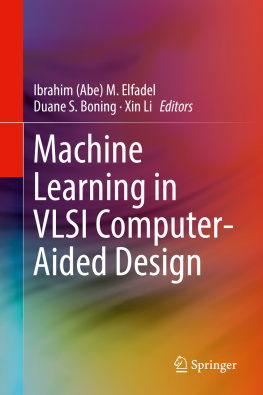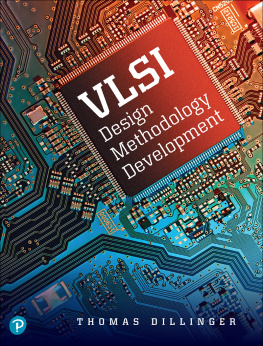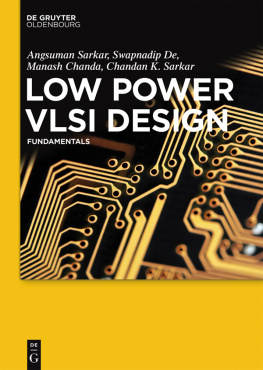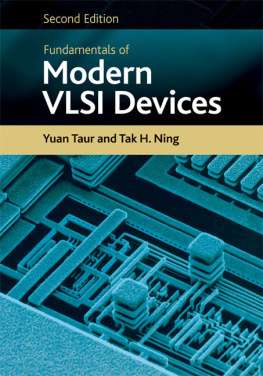Poornima Mrs.K - Principles Of CMOS VLSI Design A Full Detailed Text Book: CMOS VLSI Design : A Circuits And Systems
Here you can read online Poornima Mrs.K - Principles Of CMOS VLSI Design A Full Detailed Text Book: CMOS VLSI Design : A Circuits And Systems full text of the book (entire story) in english for free. Download pdf and epub, get meaning, cover and reviews about this ebook. year: 2021, publisher: UNKNOWN, genre: Children. Description of the work, (preface) as well as reviews are available. Best literature library LitArk.com created for fans of good reading and offers a wide selection of genres:
Romance novel
Science fiction
Adventure
Detective
Science
History
Home and family
Prose
Art
Politics
Computer
Non-fiction
Religion
Business
Children
Humor
Choose a favorite category and find really read worthwhile books. Enjoy immersion in the world of imagination, feel the emotions of the characters or learn something new for yourself, make an fascinating discovery.

- Book:Principles Of CMOS VLSI Design A Full Detailed Text Book: CMOS VLSI Design : A Circuits And Systems
- Author:
- Publisher:UNKNOWN
- Genre:
- Year:2021
- Rating:4 / 5
- Favourites:Add to favourites
- Your mark:
- 80
- 1
- 2
- 3
- 4
- 5
Principles Of CMOS VLSI Design A Full Detailed Text Book: CMOS VLSI Design : A Circuits And Systems: summary, description and annotation
We offer to read an annotation, description, summary or preface (depends on what the author of the book "Principles Of CMOS VLSI Design A Full Detailed Text Book: CMOS VLSI Design : A Circuits And Systems" wrote himself). If you haven't found the necessary information about the book — write in the comments, we will try to find it.
Poornima Mrs.K: author's other books
Who wrote Principles Of CMOS VLSI Design A Full Detailed Text Book: CMOS VLSI Design : A Circuits And Systems? Find out the surname, the name of the author of the book and a list of all author's works by series.
Principles Of CMOS VLSI Design A Full Detailed Text Book: CMOS VLSI Design : A Circuits And Systems — read online for free the complete book (whole text) full work
Below is the text of the book, divided by pages. System saving the place of the last page read, allows you to conveniently read the book "Principles Of CMOS VLSI Design A Full Detailed Text Book: CMOS VLSI Design : A Circuits And Systems" online for free, without having to search again every time where you left off. Put a bookmark, and you can go to the page where you finished reading at any time.
Font size:
Interval:
Bookmark:
VLSI Design
 By
ByMrs.K.Poornima
ASSISTANT PRO FESSOR
DEPARTMENT OF ELECTRONICS AND COMMUNICATION ENGINEERING
SASURIE COLLEGE OF ENGINEERING
VIJAYAMANGALAM 638 056
QUALITY CERTIFICATE
Class
: EC2354
: VLSI Design : III Year ECE
Signature of the Author
K.POORNIMA ASSISTANT PROFESSOR
This is to certify that the course material being prepared by Mrs.K.Poornima is of adequate quality. She has referred more than five books among them minimum one is from aboard author.
Signature of HD
N.RAMKUMAR
ASSISTANT PROFESSOR
EC2354 VLSI DESIGN L T P C 3 0 0 3
To introduce the technology, design concepts and testing of Very Large Scale Integrated Circuits.
To learn the basic CMOS circuits.
To learn the CMOS process technology.
To learn techniques of chip design using programmable devices.
To learn the concepts of designing VLSI subsystems.
To learn the concepts of modeling a digital system using Hardware Description Language.
V effects, DC transfer characteristics - CMOS technologies, Layout design Rules, CMOS process
enhancements, Technology related CAD issues, Manufacturing issues
UNIT II CIRCUIT CHARACTERIZATION AND SIMULATION 9 Delay estimation, Logical effort and Transistor sizing, Power dissipation, Interconnect,
Design margin, Reliability, ScalingSPICE tutorial, Device models, Device
characterization, Circuit characterization, Interconnect simulation
UNIT III COMBINATIONAL AND SEQUENTIAL CIRCUIT DESIGN 9 Circuit families Low power logic design comparison of circuit families Sequencing
static circuits, circuit design of latches and flip flops, Static sequencing element methodologysequencing dynamic circuits synchronizers
UNIT IV CMOS TESTING 9 Need for testing- Testers, Text fixtures and test programs- Logic verification- Silicon
debug principles- Manufacturing test Design for testability Boundary scan
UNIT V SPECIFICATION USING VERILOG HDL 9 Basic conceptsidentifiersgate primitives,
procedural assignments conditional statements,
switch level modeling, Design hierarchies, Behavioral
gate delays, operators, timing controls, Data flow and RTL, structural gate level and RTL modeling, Test benches, Structural gate level description of decoder, equality detector, comparator, priority encoder, half adder, full adder, Ripple carry adder, D latch and D flipflop.
1. Weste and Harris: CMOS VLSI DESIGN (Third edition) Pearson Education, 2005 2. Uyemura J.P: Introduction to VLSI circuits and systems, Wiley 2002.
1. D.A Pucknell & K.Eshraghian Basic VLSI Design, Third edition, PHI, 2003
2. Wayne Wolf, Modern VLSI design, Pearson Education, 2003
3. M.J.S.Smith: Application specific integrated circuits, Pearson Education, 1997
4. J.Bhasker: Verilog HDL primer, BS publication,2001
5. Ciletti Advanced Digital Design with the Verilog HDL, Prentice Hall of India, 2003
1.1 Prerequisites 1
1.2 A brief History 1
1.3 MOS transistor 2
1.4 Ideal I-V characteristics 3
1.5 C-V characteristics 3
1.6 Non ideal I- V effects 4
1.7 DC transfer characteristics 4
1.8 CMOS technologies 7
1.13 2 Marks with answer 21 UNIT II CIRCUIT CHARACTERIZATION AND SIMULATION
2.1 Prerequisites 25
2.2 Delay estimation 25
2.3 Logical effort 26
2.4 Transistor sizing 28
2.5 Power dissipation 28
2.6 Interconnect 32
2.7 Design margin 32
2.8 Reliability 33
2.9 Scaling 34 2.10 SPICE tutorial, Device models 36 2.11 Device & Circuit characterization 44 2.13 2 Marks with answer 52 UNIT III COMBINATIONAL AND SEQUENTIAL CIRCUIT DESIGN
3.1 Prerequisites 56
3.2 Circuit families 56
3.3 Low power logic design 60
3.4 Comparison of circuit families 60
3.5 Sequencing static circuits 60
3.6 Circuit design of latches and flip flops 61
3.7 Static sequencing element 67
3.8 Sequencing dynamic circuits 67
3.9 Synchronizers 68 3.10 2 Marks with answer 69
4.1 Prerequisites 73
4.2 Need for testing 73
4.3 Testers, Text fixtures and test 74programs
4.5 Silicon debug principle 81
4.7 Design for testability 82
4.9 2 Marks with answer 86
UNIT V SPECIFICATION USING VERILOG HDL
5.1 Prerequisites 91
5.2 Basic concepts 91
5.3 Identifiers 94
5.4 Gate primitives 95
5.5 Gate delays 98
5.6 Operators 99
5.7 Timing controls 101
5.8 Procedural assignments conditional 103statements
5.11 Behavioral and RTL modeling, Test 111benches
5.14 Comparator, priority encoder 118
5.15 Half adder, full adder, Ripple carry 120adder, D latch and D flip flop.
5.17 University Question 127
5.18 Important Question and Answer 135
CMOS TECHNOLOGY PREREQUISITES
An MOS (Metal-Oxide-Silicon) structure is created by superimposing several layers of conducting, insulating, and transistor forming materials.
After a series of processing steps, a typical structure might consists of levels called diffusion, polysilicon, and metal that are separated by insulating layers. CMOS technology provides two types of transistors, an n-type transistor (n MOS) and a p-type transistor (p MOS).
The area separating the n regions is capped with a sandwich consisting of an insulator and a conducting electrode called the GATE.
Similarly, for the p-transistor the structure consists of a section of n-type silicon separating two p-type diffused areas.
1.1 A BRIEF HISTORY
In an n-type MOS transistor (i.e.,nMOS), the majority carriers are electrons.
For gate voltage less than a threshold value, the channel is cut-off, thus causing a very low drain- to-source current.
Font size:
Interval:
Bookmark:
Similar books «Principles Of CMOS VLSI Design A Full Detailed Text Book: CMOS VLSI Design : A Circuits And Systems»
Look at similar books to Principles Of CMOS VLSI Design A Full Detailed Text Book: CMOS VLSI Design : A Circuits And Systems. We have selected literature similar in name and meaning in the hope of providing readers with more options to find new, interesting, not yet read works.
Discussion, reviews of the book Principles Of CMOS VLSI Design A Full Detailed Text Book: CMOS VLSI Design : A Circuits And Systems and just readers' own opinions. Leave your comments, write what you think about the work, its meaning or the main characters. Specify what exactly you liked and what you didn't like, and why you think so.

